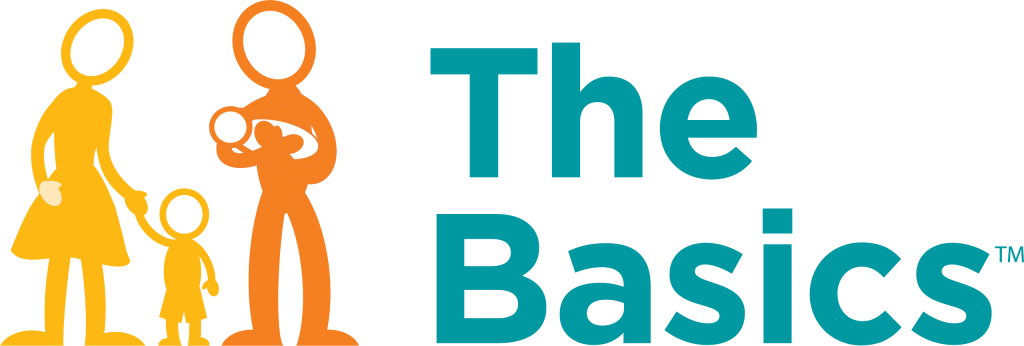
Talk, Sing and Point
WHY?
Babies are learning language from the moment they are born. To a newborn baby, speech is just sound. Then, day by day, they learn that the sounds have meaning. This process depends on how much people talk to them. Every time you talk, sing or point to what you are talking about, you provide clues to the meaning of what you are saying. You are providing important information to their brains about how language works.
As your child develops, talking with them and answering their questions is a way to teach them about the world. By talking with them, you will also get to know the fascinating person they are becoming!
Talk A Lot Talk to your baby from the time they are born during activities like changing, feeding, bathing and while running errands. Describe what you are doing. Label the objects around you by naming and pointing to them.
Go Back and Forth When your baby makes a sound, show excitement in your face and voice! Respond to their sound with words. See how long you can keep the “conversation” going. It is very powerful when the two of you can stay focused on each other for a while.
Use a Playful Voice Talk with a gentle, playful voice. Exaggerate the sounds of the words. This may feel silly at first, but it is actually very important. Babies pay extra attention and learn more when you talk this way.
Use Real Words Don’t just use “baby talk,” also use real words. The more words your baby hears, the larger their vocabulary will grow. Think of words as nourishment for your baby’s brain!
Sing Sing songs to your baby. This is a fun way for them to learn language. You might have certain songs for special times of the day, like bath time or before bedtime.
Use Any Language It doesn’t matter what language you speak with your infant. All languages are equally beneficial.
Rhyme Time Make up rhyming chants for daily routines starring your baby. A bath rhyme might go like this “Soapy Samantha in the tub/Rub-a-dub-dub”
Name Body Parts When changing or dressing your baby, make a game of naming and pointing to body parts. “Where’s Oliver’s nose?” Trying singing a round of “Head, shoulders, knees and toes.”
Step by Step As you go about daily activities with your child, talk about the steps involved. When starting a bath say “First we turn on the warm water. Then we add some cold water until it’s just right.”
Ask and Answer Questions Engage your baby by asking and answering questions about the things that interest them. “Does the ball fit into the tube?” Wait to see how they respond. Then help provide the answer. “No, it’s too big.”
Point to Objects Point to objects and name them, especially things that interest your child like body parts or familiar objects around the home. Older infants will also start to communicate by pointing.
Follow Their Interests Your baby shows you what they’re interested in by looking or reaching. If it’s safe, move those objects closer so your baby can examine them. Name them and describe their features.
Describe Life Talk about the things you’re doing and what is going on around you. Have conversations as you walk around the neighborhood or do errands.
Be Specific The more specific you can be with words, the more your child will learn. For example, instead of saying “Let’s go,” you could say, “Let’s go shopping at the grocery store to buy some food.”
Add Ideas Help grow your child’s vocabulary by expanding on what they say. For example, if they say “doggie,” you can respond with, “Yes, that is a doggie. That doggie is brown and soft.”
Listen and Respond Listen to your toddler’s questions and answer them. Have a conversation. This is when the most powerful learning takes place.
Ask Questions Get your toddler thinking. Have them explain what they are doing or what they think is going to happen. You may get some funny answers!
Use Your Hands When you talk about something, point to it. This helps your child understand what you mean. Encourage your child to point too. “Can you point to the triangle?” This will help them connect new words to the objects they represent.
Sing and Recite Sing songs and recite nursery rhymes. Choose ones you remember from your own childhood, read in books, or make up new ones.
Use Any Language It doesn’t matter what language you speak with your toddler. All languages are equally beneficial.
Fill in the Blank When you sing your child’s favorite songs, leave out words for them to fill in. Or you can say the wrong word and see if they catch you.
Rhyme Time Make up rhyming chants for daily routines starring your baby. A bath rhyme might go like this “Soapy Samantha in the tub/Rub-a-dub-dub”
Photo Album Sit with your child and look at photos of family members, friends or pets. Talk about what you see in the pictures and the special details or memories.
Out and About Errands—from the post office to the pharmacy—teach your child about the community and the people in it. Talk about the tasks involved. If you’re not in a hurry, lift your child up so they can see behind the counter.
I Spy Play I Spy. For example, say “I spy a bird. Can you find it?” If they have trouble finding it, give a hint about where to look. You can play I Spy almost anywhere.
Follow Their Fingers Young toddlers communicate with gestures, especially pointing. Label and talk about the things they point to. Encourage your child to point to the objects you name. “Where is the pig. There it is.”
Remember the Day In the evening, get cozy and talk to your child about what happened during the day. Remember what you did and the people you saw. Was it fun? Was it hard?
Step by Step As you go about daily activities with your child, talk about the steps involved. When starting a bath say “First we turn on the warm water. Then we add some cold water until it’s just right.”
Ask Questions Ask your child questions about things that interest them. Show interest in their answers and follow up to keep the conversation going. See if you can go back and forth 2-3 times
Review The Day Ask your child about their “high” and “low” for the day. What moments stood out to them?
Expand On What They Say When your child mentions something, expand on what they say and introduce new words related to that topic.
Fill In The Blank When you sing your child’s favorite songs, leave out words for them to fill in. Or you can say the wrong word and see if they catch you.
All About Me Help your child learn their full name, address, and phone number. You can teach it to the tune of their favorite songs.

